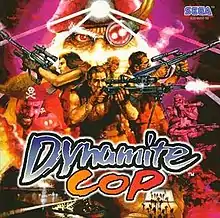Dynamite Cop
Dynamite Cop, known in Japan as Dynamite Deka 2 (ダイナマイト刑事2, Dainamaito Deka Tsu), is a 1998 beat 'em up video game published by Sega and initially released in arcades on Sega Model 2 hardware. It is the sequel to the 1996 game, Dynamite Deka which was released outside Japan as Die Hard Arcade. The game was ported to the Dreamcast and released internationally in 1999, this time without the Die Hard license. A second sequel, Asian Dynamite, was released only in arcades.
| Dynamite Cop | |
|---|---|
 Dynamite Cop | |
| Developer(s) | AM1 |
| Publisher(s) | Sega |
| Director(s) | Makoto Uchida |
| Producer(s) | Rikiya Nakagawa |
| Designer(s) | Makoto Uchida |
| Composer(s) | Howard Drossin |
| Platform(s) | Arcade, Dreamcast |
| Release | Arcade
|
| Genre(s) | Beat 'em up |
| Mode(s) | Single player, multiplayer |
| Arcade system | Sega Model 2 |
Gameplay
Dynamite Cop is a 3D beat 'em up for up to two players in which players play as either Bruno Delinger, Jean Ivy, or Eddie Brown and fight through levels on board a cruise ship and on a deserted island to save the President's daughter from a band of modern-day pirates led by Wolf "White Fang" Hongo, the main antagonist from the first game. The classic Sega arcade game Tranquilizer Gun (1980) is included as a bonus game on the Dreamcast version. Clearing all missions will enable you to play Tranquilizer Gun an unlimited number of times.
Appearances in other games
Its main character, Delinger, makes a cameo appearance in The House of the Dead 2 as a playable character via a special item obtainable in the original mode (present in home versions of The House of the Dead 2). Bruno Delinger also makes an appearance in Project X Zone as a solo unit character.
A chicken-leg from Golden Axe makes a cameo appearance on the Island stage.
Reception
| Aggregator | Score |
|---|---|
| GameRankings | 58%[2] |
| Publication | Score |
|---|---|
| AllGame | (ARC) (DC) |
| Edge | 5/10[5] |
| Famitsu | 30/40[6] |
| Game Informer | 7/10[7] |
| GameFan | 70%[8] |
| GamePro | |
| GameRevolution | D+[10] |
| GameSpot | 6.1/10[11] |
| GameSpy | 4/10[12] |
| IGN | 4.1/10[1] |
| Next Generation | |
| The Cincinnati Enquirer |
In Japan, Game Machine listed Dynamite Cop on their August 1, 1998 issue as being the fourth most-successful arcade game of the year.[15]
Jeff Chen reviewed the Dreamcast version of the game for Next Generation, rating it three stars out of five, and stated that "An entertaining, if somewhat last-generation-looking title."[13]
The Dreamcast version received "mixed" reviews according to the review aggregation website GameRankings.[2] In Japan, Famitsu gave it a score of 30 out of 40.[6]
References
- Justice, Brandon (November 2, 1999). "Dynamite Cop". IGN. Retrieved November 26, 2016.
- "Dynamite Cop! for Dreamcast". GameRankings. Retrieved November 26, 2016.
- Williamson, Colin. "Dynamite Cop (ARC) - Review". AllGame. Archived from the original on November 15, 2014. Retrieved November 26, 2016.
- Marriott, Scott Alan. "Dynamite Cop! (DC) - Review". AllGame. Archived from the original on November 15, 2014. Retrieved November 26, 2016.
- Edge staff (August 1999). "Dynamite Deka 2 (DC)". Edge. No. 74.
- "ドリームキャスト - ダイナマイト刑事2". Famitsu. Vol. 915. June 30, 2006. p. 49.
- Fitzloff, Jay; Anderson, Paul; Reiner, Andrew (November 1999). "Dynamite Cop". Game Informer. No. 79. Archived from the original on May 23, 2000. Retrieved November 26, 2016.
- "REVIEW for Dynamite Cop". GameFan. November 1, 1999.
- Scary Larry (November 7, 1999). "Dynamite Cop Review for Dreamcast on GamePro.com". GamePro. Archived from the original on October 29, 2004. Retrieved November 26, 2016.
- Liu, Johnny (January 2000). "Dynamite Cop Review". Game Revolution. Archived from the original on October 9, 2015. Retrieved November 26, 2016.
- Stahl, Ben (June 4, 1999). "Dynamite Cop Review". GameSpot. Retrieved November 26, 2016.
- Fragmaster (November 10, 1999). "Dynamite Cop". PlanetDreamcast. Archived from the original on January 31, 2009. Retrieved November 26, 2016.
- Chen, Jeff (September 1999). "Finals". Next Generation. Vol. 2 no. 1. Imagine Media. p. 83.
- Bottorff, James (1999). "Sega's new Dynamite Cop a dud". The Cincinnati Enquirer. Archived from the original on April 28, 2001. Retrieved November 26, 2016.
- "Game Machine's Best Hit Games 25 - TVゲーム機ーソフトウェア (Video Game Software)". Game Machine (in Japanese). No. 569. Amusement Press, Inc. 1 August 1998. p. 25.